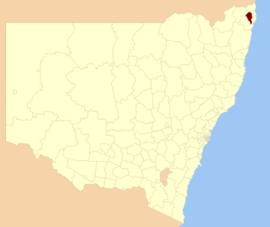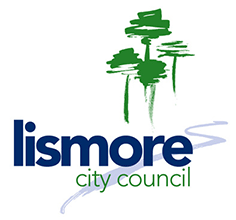City of Lismore
The City of Lismore is a local government area in the Northern Rivers region of New South Wales, Australia. The seat of the local government area is Lismore, a major regional centre of the state.
| Lismore City New South Wales | |||||||||||||||
|---|---|---|---|---|---|---|---|---|---|---|---|---|---|---|---|
 Location in NSW | |||||||||||||||
| Coordinates | 28°49′S 153°17′E | ||||||||||||||
| Population |
| ||||||||||||||
| • Density | 33.44/km2 (86.6/sq mi) | ||||||||||||||
| Established | 1879 (municipality): 9 September 1946 (city)[3] | ||||||||||||||
| Area | 1,290 km2 (498.1 sq mi)[4] | ||||||||||||||
| Mayor | Isaac Smith (Country Labor) | ||||||||||||||
| Council seat | Goonellabah | ||||||||||||||
| Region | Northern Rivers | ||||||||||||||
| State electorate(s) | Lismore | ||||||||||||||
| Federal Division(s) | Page | ||||||||||||||
 | |||||||||||||||
| Website | Lismore City | ||||||||||||||
| |||||||||||||||
The Mayor of Lismore City Council is Cr. Isaac Smith, a member of Country Labor.
Towns and localities
- Lismore suburban
- Chilcotts Grass
- East Lismore
- Girards Hill
- Goonellabah
- Howards Grass
- Lismore
- Lismore Heights
- Loftville
- North Lismore
- Richmond Hill
- South Lismore
- Other areas
- Bentley
- Bexhill
- Blakebrook
- Blue Knob
- Booerie Creek
- Buckendoon
- Caniaba
- Clunes
- Coffee Camp
- Corndale
- Dorroughby
- Dungarubba
- Dunoon
- East Coraki
- Eltham
- Fernside
- Georgica
- Goolmangar
- Gundurimba
- Jiggi
- Keerrong
- Koonorigan
- Larnook
- Leycester
- Lillian Rock
- Lindendale
- McKees Hill
- Modanville
- Monaltrie
- Nimbin
- North Woodburn
- Numulgi
- Pearces Creek
- Rock Valley
- Rosebank
- Rous Mill
- Ruthven
- South Gundurimba
- Terania Creek
- The Channon
- Tregeagle
- Tucki Tucki
- Tuckurimba
- Tullera
- Tuncester
- Tuntable Creek
- Whian Whian
- Woodlawn
- Wyrallah
- Yeagerton
Heritage listings
The City of Lismore has a number of heritage-listed sites, including:
Demographics
At the 2011 census, there were 42,766 people in the Lismore local government area, of these 48.9 per cent were male and 51.1 per cent were female. Aboriginal and Torres Strait Islander people made up 4.5 per cent of the population, which was significantly higher than the national and state averages of 2.5 per cent. The median age of people in the City of Lismore area was 40 years, which was marginally higher than the national median of 37 years. Children aged 0 – 14 years made up 19.7 per cent of the population and people aged 65 years and over made up 14.7 per cent of the population. Of people in the area aged 15 years and over, 42.8 per cent were married and 14.5 per cent were either divorced or separated.[6]
Population growth in the City of Lismore area between the 2001 census and the 2006 census was 1.5 per cent; and in the subsequent five years to the 2011 census, the population growth was 1.3 per cent. When compared with total population growth of Australia for the same periods, being 5.78 per cent and 8.32 per cent respectively, population growth in the Lismore local government area was significantly lower than the national average.[7][8] The median weekly income for residents within the City of Lismore area was marginally lower than the national average.[6]
At the 2011 census, the proportion of residents in the Lismore local government area who stated their ancestry as Australian or Anglo-Celtic exceeded 83 per cent of all residents (national average was 65.2 per cent). In excess of 24 per cent of all residents in the City of Lismore at the 2011 census nominated no religious affiliation, compared to the national average of 22.3 per cent. Meanwhile, affiliation with Christianity was 55 per cent, which was slightly higher than the national average of 50.2 per cent. As at the census date, compared to the national average, households in the Lismore local government area had a significantly lower than average proportion (3.5 per cent) where two or more languages are spoken (national average was 20.4 per cent); and a significantly higher proportion (92.9 per cent) where English only was spoken at home (national average was 76.8 per cent).[6]
| Selected historical census data for the City of Lismore local government area | |||||
|---|---|---|---|---|---|
| Census year | 2001[7] | 2006[8] | 2011[6] | ||
| Population | Estimated residents on Census night | 41,572 | 42,210 | 42,766 | |
| LGA rank in terms of size within New South Wales | 48 | ||||
| % of New South Wales population | 0.62% | ||||
| % of Australian population | 0.22% | ||||
| Cultural and language diversity | |||||
| Ancestry, top responses | Australian | 31.4% | |||
| English | 30.0% | ||||
| Irish | 10.8% | ||||
| Scottish | 8.2% | ||||
| German | 3.5% | ||||
| Language, top responses (other than English) | Italian | 0.2% | |||
| German | 0.6% | ||||
| Mandarin | n/c | n/c | |||
| French | 0.1% | ||||
| Auslan | n/c | ||||
| Religious affiliation | |||||
| Religious affiliation, top responses | No Religion | 15.2% | |||
| Catholic | 25.8% | ||||
| Anglican | 21.9% | ||||
| Uniting Church | 7.8% | ||||
| Presbyterian and Reformed | 6.4% | ||||
| Median weekly incomes | |||||
| Personal income | Median weekly personal income | A$378 | A$469 | ||
| % of Australian median income | 81.1% | ||||
| Family income | Median weekly family income | A$993 | A$1,123 | ||
| % of Australian median income | 84.8% | ||||
| Household income | Median weekly household income | A$760 | A$907 | ||
| % of Australian median income | 74.0% | ||||
Council
Current composition and election method
Lismore City Council is composed of eleven Councillors, including the Mayor, for a fixed four-year term of office. The Mayor is directly elected while the ten other Councillors are elected proportionally as one entire ward. The most recent election was held on 10 September 2016, and the makeup of the Council, including the Mayor, is as follows:[9][10]
| Party | Councillors | |
|---|---|---|
| Country Labor | 3 | |
| Independents | 5 | |
| Our Sustainable Future | 1 | |
| Greens | 2 | |
| Total | 11 | |
The current Council elected in 2016 is:
| Councillor | Party | Notes | |
|---|---|---|---|
| Isaac Smith | Country Labor | Mayor[9] | |
| Darlene Cook | Country Labor | Deputy Mayor[11] | |
| Edwina Lloyd | Country Labor | ||
| Greg Bennett | Independent | ||
| Neil Marks | Independent | ||
| Nancy Zambelli-Casson | Independent | ||
| Bill Moorhouse | Independent | ||
| Gianpiero Battista | Independent | ||
| Elly Bird | Our Sustainable Future | ||
| Vanessa Grindon-Ekins | Greens | ||
| Adam Guise | Greens | ||
Sister cities
Lismore has sister city relations with the following cities:[12]




References
- Australian Bureau of Statistics (27 June 2017). "Lismore (C)". 2016 Census QuickStats. Retrieved 16 November 2017.

- "3218.0 – Regional Population Growth, Australia, 2017-18". Australian Bureau of Statistics. 27 March 2019. Retrieved 27 March 2019. Estimated resident population (ERP) at 30 June 2018.
- "Historical information about the City of Lismore". City of Lismore. 2016. Retrieved 28 May 2016.
- "Lismore City Council". Department of Local Government. Archived from the original on 6 September 2006. Retrieved 19 November 2006.
- "High Conservation Value Old Growth forest". New South Wales State Heritage Register. Office of Environment and Heritage. H01487. Retrieved 18 May 2018.
- Australian Bureau of Statistics (31 October 2012). "Lismore (C)". 2011 Census QuickStats. Retrieved 22 May 2016.

- Australian Bureau of Statistics (9 March 2006). "Lismore (C)". 2001 Census QuickStats. Retrieved 22 May 2016.
- Australian Bureau of Statistics (25 October 2007). "Community Profile Series : Lismore (C) (Local Government Area)". 2006 Census of Population and Housing. Retrieved 27 May 2016.
- "Lismore City Council - Mayoral Election". Local Government Election 2016. New South Wales Electoral Commission. 17 September 2016. Retrieved 20 October 2016.
- "Lismore City Council: Summary of First Preference and Group Votes for each Candidate". Local Government Election 2016. New South Wales Electoral Commission. 17 September 2016. Retrieved 20 October 2016.
- "Lismore City Council - Mayoral Election". Local Government Election 2016. New South Wales Electoral Commission. 17 September 2016. Retrieved 20 October 2016.
- "Sister Cities". Lismore City Council. Archived from the original on 30 August 2007.